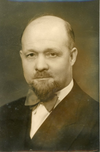| No. | Picture | Minister of Air | Took office | Left office | Time in office | Party | Cabinet |
|---|
| 1 | | Eynac, Laurent Laurent Eynac
(1886–1970) | 14 September 1928 | 13 December 1930 | 2 years, 90 days | RI | Briand XI
Tardieu I
Chautemps I
Tardieu II |
| 2 | | Painlevé, Paul Paul Painlevé
(1863–1933) | 13 December 1930 | 27 January 1931 | 45 days | PRS | Steeg |
| 3 | | Dumesnil, Jacques Jacques-Louis Dumesnil
(1882–1956) | 27 January 1931 | 20 February 1932 | 1 year, 24 days | PRV | Laval I–II–III |
| (2) | | Painlevé, Paul Paul Painlevé
(1863–1933) | 3 June 1932 | 29 January 1933 | 344 days | PRS | Tardieu III |
| 4 | | Cot, Pierre Pierre Cot
(1895–1977) | 31 January 1933 | 9 February 1934 | 1 year, 11 days | PRV | Sarraut I
Daladier I–II |
| 5 | | Denain, Victor Victor Denain
(1880–1952) | 9 February 1934 | 24 January 1936 | 1 year, 349 days | Independent | Doumergue II
Flandin
Bouisson |
| 6 | | Déat, Marcel Marcel Déat
(1894–1955) | 24 January 1936 | 4 June 1936 | 132 days | USR | Sarraut II |
| (4) | | Cot, Pierre Pierre Cot
(1895–1977) | 4 June 1936 | 18 January 1938 | 1 year, 228 days | PRV | Blum I–II |
| 7 | | Chambre, Guy Guy La Chambre
(1898–1975) | 18 January 1938 | 21 March 1940 | 2 years, 63 days | PRV | Blum II
Daladier III |
| (1) | | Eynac, Laurent Laurent Eynac
(1886–1970) | 21 March 1940 | 16 June 1940 | 87 days | PRV | Reynaud |











